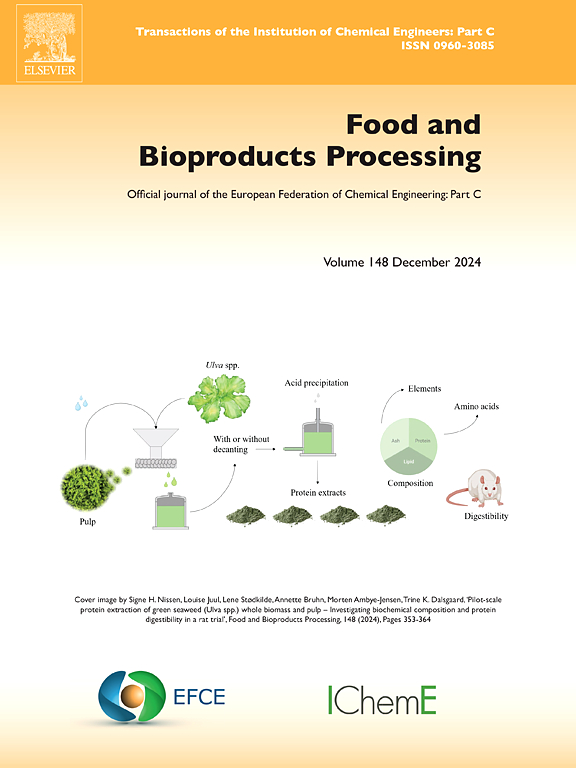Preparation and application of bioadhesive hydrogel powder loaded with quorum sensing inhibitor isomaltitol for salmon preservation
IF 3.5
2区 农林科学
Q2 BIOTECHNOLOGY & APPLIED MICROBIOLOGY
引用次数: 0
Abstract
Salmon is susceptible to spoilage and single cold storage is insufficient for effectively extending its shelf life. The objective of this study was to investigate the impact of hydrogel powder loaded with isomaltitol on the shelf life of salmon. Rheological analysis of the hydrogel revealed that its G' consistently exceeded G'', without any crossover point, indicating gradual gelatinization and the formation of an elastic solid. In conjunction with Fourier-transform infrared spectroscopy (FTIR) and X-ray diffraction (XRD) results, the peaks at 3398 cm⁻¹ for gelatin and 3446 cm⁻¹ for sodium alginate were observed in GSDH-2 and showed a shift. The characteristic peak at 2997 cm⁻¹ for isomaltitol was not present in GSDH-2, but was observed in the spectrum of GSIH-2 and became more prominent. These results suggest successful hydrogel preparation. Thermogravimetric analysis (TGA) results showed that the hydrogel lost only 13 % at 200°C. Scanning electron microscopy (SEM) analysis revealed a three-dimensional network and distinct void structure in the hydrogel, indicating its suitability for practical applications, resistance to volatilization, ability to encapsulate drugs, and ability to swell when in contact with water. The preservation experiment showed that the TVB-N value in the control group reached 15 mg/100 g on the third day, while the GSIP treatment group reached this value on the ninth day. Additionally, the TBA value in the GSIP treatment group decreased by 67.2 % under the same storage duration, and the degradation of myofibrillar protein was inhibited by 60.6 %, extending the shelf life of salmon by one week. This finding confirms the potential of hydrogel loaded with isomaltitol as a new preservation method.
负载群体感应抑制剂异麦芽糖醇的生物胶粘剂水凝胶粉的制备及其在三文鱼保鲜中的应用
三文鱼易变质,单次冷藏不足以有效延长其保质期。本研究的目的是研究装载异麦芽糖醇的水凝胶粉对鲑鱼货架期的影响。对水凝胶的流变学分析表明,其G′持续大于G′,没有任何交叉点,表明水凝胶逐渐糊化,形成弹性固体。结合傅里叶变换红外光谱(FTIR)和x射线衍射(XRD)结果,在GSDH-2中观察到明胶的峰3398 cm⁻¹ 和海藻酸钠的峰3446 cm⁻¹ ,并出现了移位。异麦芽糖醇在2997 cm(⁻¹ )处的特征峰在GSDH-2中不存在,但在GSIH-2的光谱中观察到了,并且变得更加突出。这些结果表明水凝胶制备成功。热重分析(TGA)结果表明,在200℃时,水凝胶的损失仅为13 %。扫描电子显微镜(SEM)分析显示,水凝胶具有三维网状结构和明显的空隙结构,表明其具有实际应用价值,具有抗挥发性、包封药物能力和与水接触时膨胀能力。保存实验表明,对照组TVB-N值在第3天达到15 mg/100 g,而GSIP处理组在第9天达到该值。GSIP处理组的TBA值在相同的贮藏时间下降低了67.2 %,肌原纤维蛋白的降解被抑制了60.6 %,使三文鱼的保质期延长了一周。这一发现证实了负载异麦芽糖醇的水凝胶作为一种新的保存方法的潜力。
本文章由计算机程序翻译,如有差异,请以英文原文为准。
求助全文
约1分钟内获得全文
求助全文
来源期刊

Food and Bioproducts Processing
工程技术-工程:化工
CiteScore
9.70
自引率
4.30%
发文量
115
审稿时长
24 days
期刊介绍:
Official Journal of the European Federation of Chemical Engineering:
Part C
FBP aims to be the principal international journal for publication of high quality, original papers in the branches of engineering and science dedicated to the safe processing of biological products. It is the only journal to exploit the synergy between biotechnology, bioprocessing and food engineering.
Papers showing how research results can be used in engineering design, and accounts of experimental or theoretical research work bringing new perspectives to established principles, highlighting unsolved problems or indicating directions for future research, are particularly welcome. Contributions that deal with new developments in equipment or processes and that can be given quantitative expression are encouraged. The journal is especially interested in papers that extend the boundaries of food and bioproducts processing.
The journal has a strong emphasis on the interface between engineering and food or bioproducts. Papers that are not likely to be published are those:
• Primarily concerned with food formulation
• That use experimental design techniques to obtain response surfaces but gain little insight from them
• That are empirical and ignore established mechanistic models, e.g., empirical drying curves
• That are primarily concerned about sensory evaluation and colour
• Concern the extraction, encapsulation and/or antioxidant activity of a specific biological material without providing insight that could be applied to a similar but different material,
• Containing only chemical analyses of biological materials.
 求助内容:
求助内容: 应助结果提醒方式:
应助结果提醒方式:


